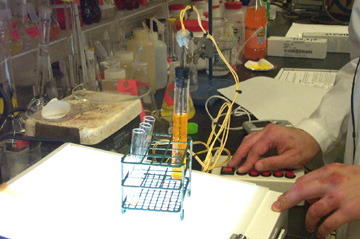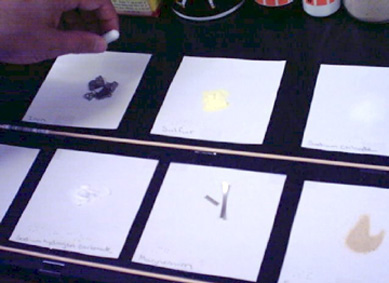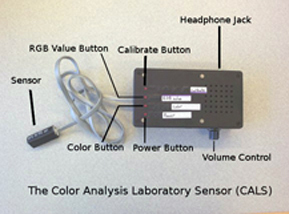The “Techniques
and Tools to Enhance Blind and Visually Impaired Students
Participation in High School Level and General Chemistry Laboratory
Classes” project has developed devices and lab procedures that
allow blind and visually impaired students to conduct general
chemistry laboratory experiments without the aid of sighted
assistants. With the support of the National Science
Foundation’s (NSF) Research in Disabilities Education (RDE)
program, Dr. Thomas Mallouk and the research team at Penn State’s
Independent Laboratory Access for the Blind project (ILAB) has
produced several devices for conducting chemistry experiments
including a hand-held, submersible audible light sensor that fits in
a test tube and coverts the light intensity to an audible
signal. Another device the team created is an inexpensive,
portable color recognizer to detect the color of a substance in a
beaker or the color of a signal on a computer screen.
The
ILAB team has been working with industry partners, including the
Vernier Software and Technology Company, to make commonly used
scientific software accessible to blind students who use the speech
output software package Job Access With Speech (JAWS), the computer
screen reading system most commonly used by blind and visually
impaired students. The new ILAB equipment and upgraded computer
software are combined with simple instructional lab modifications,
such as lining up components and tasks for an experiment along a
dowel rod with Braille instructions accompanying each step of an
experiment. These science lab tools have been used by blind and
visually impaired students at the Indiana School for the Blind and at
the Hopewell Valley Central High School, in Pennington, N.J. This
research team is currently investigating whether the use of these
devices and instructional lab modifications influence student
attitudes toward science education.
Partners:
Vernier Software and Technology Company, Indiana School for the
Blind, Hopewell Valley Central High School
More Photos:

|
This
simple hand-held, submersible audible light sensor, also known as
SALS, was created by ILAB as a device that can indicate a change
in color of a solution, and can also detect the formation of a
precipitate in a test tube in real time. The light sensor is
converted into an audible pitch so that those who are
visually impaired can interpret findings.
Credit: Thomas Mallouk, Pennsylvania State University University Park
Permission Granted
|

|
In
the dowel rod and Braille organizers for array experiments,
several solid substances are laid out on paper in order to observe
effects such as magnetic separation of a mixture of powders.
The set up was first modified by Braille-labeling each square. The
second modification was to use tape to secure dowel rods along the
rows of labeled squares. This allows the student to find the
substances easily, without accidentally mixing or moving the
squares.
Credit: Thomas Mallouk, Pennsylvania State University University Park
Permission Granted
|

|
The
Color Analysis Laboratory
Sensor (CALS) is an inexpensive color recognizer that
was developed in the Chemistry Electronics Shop at Penn State.
CALS consists of a hand-held probe connected to a digital
controller box, that reports the color of a solid object or
surface (e.g., a powder in the chemistry laboratory, a piece of
fabric, or the color in a picture) to the user. It is not
intended for use in solutions because neither the probe nor the
controller are submersible. CALS does not reliably report the
colors of solutions inside glass containers because of reflection
from the surface of the glass. Before use, the sensor is
calibrated by holding the probe up to a piece of white paper.
The probe is then held next to the test object, and the controller
box speaks the color. The user can also choose to have CALS
report the color numerically as a series of red, green, blue (RGB)
and white color values.
Credit: Thomas Mallouk, Pennsylvania State University University Park
Permission Granted
|
